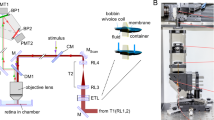Abstract
In our eyes, as in the eyes of all vertebrates, images of the environment are projected onto an inverted retina, where photons must pass through most of the retinal layers before being captured by the light-sensitive cells. Light scattering in these retinal layers must decrease the signal-to-noise ratio of the images and thus interfere with clear vision. Surprisingly however, our eyes display splendid visual abilities. This apparent contradiction could be resolved if intraretinal light scattering were to be minimized by built-in optical elements that facilitate light transmission through the tissue. Indeed, we were able to show that one function of radial glial (Müller) cells is to act as effective optical fibers in the living retina, bypassing the light-scattering structures in front of the light-sensitive cells. Each Müller cell serves as a ‘private’ light cable, providing one individual cone photoreceptor cell with its appropriate pixel of the environmental image, thus optimizing special resolution and visual acuity.






Similar content being viewed by others
References
Agte S, Junek S, Matthias S et al (2011) Müller glial cell-provided cellular light guidance through the vital guinea-pig retina. Biophys J 101:2611–2619
Bass M (1995) Handbook of optics, volume I: fundamentals, techniques, and design. McGraw-Hill, New York
Enoch JM (1961) Visualization of wave-guide modes in retinal receptors. Am J Ophthalmol 51:1107–1118
Enoch JM (1963) Optical properties of the retinal receptors. J Opt Soc Am 53:71–85
Enoch JM, Glisman LE (1966) Physical and optical changes in excised retinal tissue. Resolution of retinal receptors as a fiber optic bundle. Invest Ophthamol Vis Sci 5:208–221
Franze K, Grosche J, Skatchkov SN et al (2007) Müller cells are living optical fibers in the vertebrate retina. Proc Natl Acad Sci U S A 104:8287–8292
Goldsmith TH (1990) Optimization, constraint, and history in the evolution of eyes. Q Rev Biol 65:285–287
Land MF, Nilsson D-E (2002) Animal eyes. Oxford University Press, New York
Puliafito CA, Hee MR, Lin CP et al (1995) Imaging of macular diseases with optical coherence tomography. Ophthalmology 102:217–229
Reichenbach A, Robinson S (1995) Phylogenetic constraints on retinal organization and development. Prog Retin Eye Res 15:139–171
Reichenbach A, Bringmann A (2010) Müller cells in the healthy and diseased retina. Springer, New York
Reichenbach A, Franze K, Agte S et al (2012) Live cells as optical fibers in the vertebrate retina. In: Yasin M, Arof H, Harun SW (eds) Selected topics on optical fiber technology. InTech, Rijeka, pp 247–270
Rodieck RW (1973) The vertebrate retina: principles of structure and function. W. H. Freeman, San Francisco
Solovei I, Kreysing M, Lanctôt C et al (2009) Nuclear architecture of rod photoreceptor cells adapts to vision in mammalian evolution. Cell 137:356–368
Tobey FL, Enoch JM, Scandrett JH (1975) Experimentally determined optical properties of goldfish cones and rods. Invest Ophthalmol 14:7–23
Valentin G (1879) Ein Beitrag zur Kenntniss der Brechungsverhältnisse der Thiergewebe. Arch Ges Physiol 19:78–105
Walls GL (1963) The Vertebrate Eye. Hafner Publishing Company, New York
Winston A, Enoch JM (1971) Retinal cone receptor as an ideal light collector. J Opt Soc Am 61:1120–1122
Zernike F (1955) How I discovered phase contrast. Science 121:345–349
Author information
Authors and Affiliations
Corresponding author
Compliance with ethical guidelines
Compliance with ethical guidelines
Conflict of interest. S. Agte, M. Francke, K. Franze and A. Reichenbach state that there are no conflicts of interest.The accompanying manuscript does not include studies on humans or animals.
Rights and permissions
About this article
Cite this article
Reichenbach, A., Agte, S., Francke, M. et al. How light traverses the inverted vertebrate retina. e-Neuroforum 5, 93–100 (2014). https://doi.org/10.1007/s13295-014-0054-8
Published:
Issue Date:
DOI: https://doi.org/10.1007/s13295-014-0054-8




